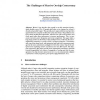Free Online Productivity Tools
i2Speak
i2Symbol
i2OCR
iTex2Img
iWeb2Print
iWeb2Shot
i2Type
iPdf2Split
iPdf2Merge
i2Bopomofo
i2Arabic
i2Style
i2Image
i2PDF
iLatex2Rtf
Sci2ools
APCSAC
2005
IEEE
2005
IEEE
The Challenges of Massive On-Chip Concurrency
Moore’s law describes the growth in on-chip transistor density, which doubles every 18 to 24 months and looks set to continue for at least a decade and possibly longer. This growth poses major problems (and provides opportunities) for computer architecture in this time frame. The problems arise from current architectural approaches, which do not scale well and have used clock speed rather than concurrency to increase performance. This, in turn, causes excessive power dissipation and circuit complexity. This paper takes a long-range position on the future of chip multiprocessors, both from the microarchitecture perspective, as well as from a systems perspective. Concurrency will come from many levels, with instruction and loop-level concurrency managed at the micro-architecture and higher levels by the system. Chip-level multiprocessors exploiting massive concurrency we term Microgrids. The directions proposed in this paper provide micro-architectural concurrency with full forward com...
| Added | 24 Jun 2010 |
| Updated | 24 Jun 2010 |
| Type | Conference |
| Year | 2005 |
| Where | APCSAC |
| Authors | Kostas Bousias, Chris R. Jesshope |
Comments (0)

